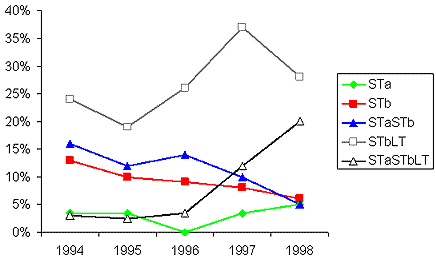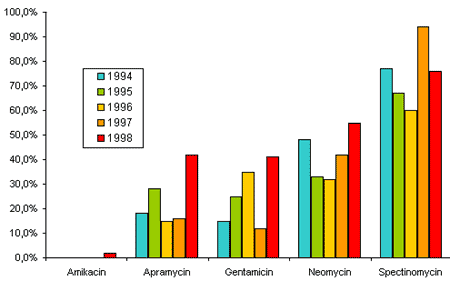E. coli diagnosis and control
1. Trends in the appearance of new virotypes of Escherichia coli from postweaning diarrhea in pigs
We demonstrated the sensitivity and specificity of colony hybridization for the detection of the genes of E. coli causing diarrhea in pigs (Harel et al., 1991). Using this technology, we have studied the trends in presence of virulence factors and antibioresistance genes in a retrospective study of O149:F4(K88) strains isolated since 1978, and we have also studied trends in the presence of virulence factors and antibioresistance in ETEC isolated in field cases of postweaning diarrhea from 1992 to the present time or isolated from two epidemiological studies of cases of postweaning diarrhea in pigs carried out in 1992 and 1998.
In our retrospective study, we observed that O149:F4 strains isolated before 1990 were predominantly of virotype LT:STb:EAST1 (Table 1) (Fairbrother et al., 2000; Fontaine et al., 2002). Since 1990, a new virotype, LT:STa:STb:EAST1:Paa, has appeared and is now as prevalent as (Fairbrother et al., 2000; Fontaine et al., 2002) or has almost replaced (Noamani et al., 2003) the original virotype.
Table 1. Virotypes of O149 ETEC isolated from 1978 to 2000
|
Virotype
|
% strains with virotype in period
|
|
78-85
(n=33)
|
86-89
(n=30)
|
90-95
(n=28)
|
97-00
(n=42)
|
|
LT:STb:EAST1:F4(K88)
|
63,6
|
86,7
|
75,0
|
23,8
|
|
LT:STb:EAST1:F4(K88):F41
|
0
|
0
|
3,6
|
0
|
|
LT:STb:STa:F4(K88)
|
0
|
0
|
0
|
2,4
|
|
LT:STb:STa:EAST1:F4(K88)
|
0
|
0
|
3,6
|
0
|
|
STa:EAST1:F4(K88):F5
|
0
|
0
|
0
|
2,4
|
|
LT:STb:EAST1:F4(K88):Paa
|
3,0
|
3,3
|
7,1
|
28,6
|
|
LT:STb:STa:EAST1:F4(K88):Paa
|
0
|
0
|
7,1
|
35,7
|
|
LT:STb:STa:EAST1:F4(K88):F5:Paa
|
0
|
0
|
0
|
4,8
|
|
LT:STb:STa:EAST1:F4(K88):F6:Paa
|
0
|
0
|
3,6
|
0
|
|
LT:STb:STa:F4(K88):Paa
|
0
|
0
|
0
|
2,4
|
|
Othersa
|
21,2
|
3,3
|
0
|
0
|
|
None
|
12,1
|
6,7
|
0
|
0
|
a LT:STb:EAST1, LT:STb:EAST1:Paa, LT:F4(K88), LT:STb:STx2e:F18, LT:STb:EAST1:F18, LT:STb:STa:STx2e:F18:AIDA, CNF1:F18, CDT:Eae
Fontaine et al., 2002
In a 1992-1993 study of pigs with diarrhea in the period up to 14 days following weaning on farms with problems of postweaning diarrhea, F18-positive isolates were more prevalent, only 9% of ETEC isolates being F4-positive, whereas 11% of ETEC isolates were F18-positive (Fairbrother et al., 1994) (Table 2). On the other hand, F4 was the predominant fimbrial adhesin in ETEC from pigs with postweaning diarrhea in Quebec, both in diagnostic cases from 1994 to 1998 (Fairbrother et al, 2000) (see Figure 1 where STb:LT and STa:STb:LT strains were F4 positive) and in a recent study of 17 farms with diarrhea in at least 15% of pigs in the first 3 weeks postweaning (Fairbrother, personal observations, 2002). In both of these latter studies, about half of the ETEC isolates produced F4 fimbriae. All F4-positive isolates were O149, most being of virotype LT:STb:EAST1:F4 in diagnostic cases of 1994, whereas half were of virotype LT:STb:EAST1:F4 and half were of virotype LT:STa:STb:EAST1:F4 in the later studies. Overall, about 2% of isolates were F18-positive and were mostly of virotype STa:STb. All other ETEC produced neither F4 nor F18, the most common virotypes being STa:STb, and STb:EAST1:AIDA.
Table 2. Presence of enterotoxin genes in E. coli isolates from piglets with or without postweaning diarrhea
|
|
% isolates positive
|
|
Enterotoxin
|
Total
|
From piglets
with diarrhea
|
From piglets without diarrhea
|
|
STb
|
11,5
|
9,8
|
13,0
|
|
STa
|
1,5
|
2,7
|
0,4
|
|
STa and STb
|
6,9
|
12,8
|
1,5
|
|
LT and STb
|
2,6
|
4,4
|
0,9
|
Fairbrother et al., 1994.
Figure 1. Trends in relative frequency of E. coli pathotypes in pigs with postweaning diarrhea in Québec from 1994 to 1998

Fairbrother et al., 2000
In our study of antibioresistance in ETEC isolated in field cases of postweaning diarrhea from 1994 to 1998, we observed a marked increase in resistance to several antibiotics (Figures 2a, 2b). Also, in a retrospective study of antimicrobial resistance genes, we have observed an increase in multi-resistance, and that many of the antibiotic resistance genes are in a state of flux driven by various selection forces such as the use of specific antimicrobials (Fairbrother et al, 2000; Fontaine et al., 2002; Maynard et al., 2003).
Figures 2a and 2b. Trends in antimicrobial resistance of E. coli isolates from pigs with postweaning diarrhea in Québec from 1994 to 1998


Reference
Fairbrother et al., 2000
We have recently developed a microarray for the detection of most of the known virulence factors of pathogenic E. coli (Bekal et al., 2003). This work has permitted us to greatly improve the diagnosis of E. coli diarrhea in animals and to better understand the role of E. coli in postweaning diarrhea of pigs.
References
Bekal S, Brousseau R, Masson L, Préfontaine G, Fairbrother JM and Harel J (2003). Rapid identification of Escherichia coli pathotypes by virulence gene detection with DNA microarrays. Journal of Clinical Microbiology 41: 2113-2125.
More details
Fairbrother JM, Harel J, D'Allaire S and Bonneau M (1994). Characterization of Escherichia coli isolated from postweaning piglets with and without diarrhea. In proceedings of the 13th Congress of the International Pig Veterinary Society, Bangkok, Thailand p. 212.
Fairbrother JM, Higgins R and Desautels C (2000). Trends in pathotypes and antimicrobial resistance of Escherichia coli isolates from weaned pigs. In proceedings of the 16th Congress of the International Pig Veterinary Society, Melbourne, Australia p. 17.
Fontaine F, Pérès S, Gyles CL and Fairbrother JM (2002). Trends in O149:K91 Enterotoxigenic Escherichia coli from pigs in Québec. In proceedings of the 17th IPVS Congress, Ames, Iowa, USA. p 70.
Harel J, Lapointe H, Fallara A, Lortie LA, Bigras-Poulin M, Larivière S and Fairbrother JM (1991). Detection of genes for fimbrial antigens and enterotoxins associated with Escherichia coli serogroups isolated from pigs with diarrhea. Journal of Clinical Microbiology 29: 745-752.
More details
Maynard C, Fairbrother JM, Bekal S, Sanschagrin F, Lévesque RC, Brousseau R, Masson L, Larivière S and Harel J (2003). Antimicrobial resistance genes in enterotoxigenic Escherichia coli O149:K91 isolates obtained over a 23-Year period from pigs. Antimicrobial Agents and Chemotherapy 47: 3214-3221.
More details
Noamani B, Fairbrother JM and Gyles CL (2003). Virulence genes of O149 enterotoxigenic Escherichia coli of postweaning diarrhea in pigs. Veterinary Microbiology 97: 87-101.
More details
Financial Support
The Conseil des recherches en pêche et en agroalimentaire du Québec (CORPAQ) and the Ministère de l'Agriculture, des Pêcheries et de l'Alimentation du Québec (MAPAQ). The Natural Sciences and Engineering Research Council of Canada for the Canadian Research Network on Bacterial Pathogens of Swine.
 Top of page
Top of page





